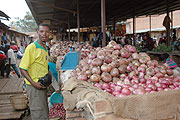The annual inflation in the month of September rose by 0.09 percent to 5.7 percent from 5.41 percent in the previous month, according to the National Institute of Statistics of Rwanda (NISR).


The annual inflation in the month of September rose by 0.09 percent to 5.7 percent from 5.41 percent in the previous month, according to the National Institute of Statistics of Rwanda (NISR).
The institute attributed the increase in inflation to a 3.6 percentage point rise in food and non-alcoholic beverages plus a hike in transport. Transport rose by 1.01 percent in the monthly of September.
The NISR said in a statement yesterday that the increase in prices of food and non-alcoholic beverages is primary attributable to the increase of prices of vegetables that rose by 9.25 percent and fish by 4.9 percent.
However, bread and cereals showed a negative change of 1.37 percent as beef gained by 0.07 percent.
Furnishing, household equipment and routine household maintenance reduced by 0.11 percent as prices of housing, water, electricity, gas and other fuels rose by only 0.33 percent.
The underlying inflation rate, which does not account for fresh food and energy, decreased by 0.17 percent to 3.6 percent in September compared to 3.77 percent in the previous month.
The prices of the fresh products had a positive annual change of 26.12 percent between September 2009 and September 2008.
The National Institute of Statistics of Rwanda delivered the new Consumer Price Index (CPI) based in February 2009, replaces the previous one which was based in 2003.
Rwanda has been experiencing low inflationary pressure of late, leading to high growth rates through increased demand.
The Ministry of Finance and Economic Planning says that Gross Domestic Product (GDP) growth in the first six months of 2009 was recorded at nine percent on the back of expansion in the industrial sector and good crop yields.
This growth comes at a time the real sector rattles with the meltdown in the global economy as well as low liquidity levels in the banking system.
Ends


